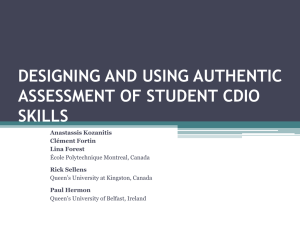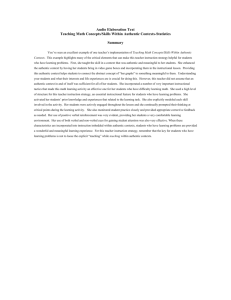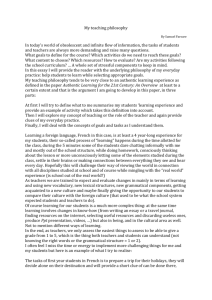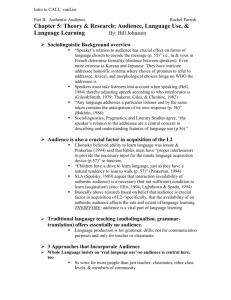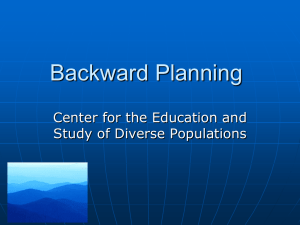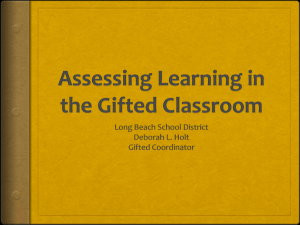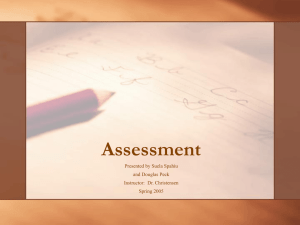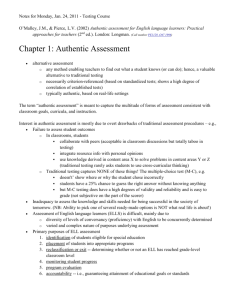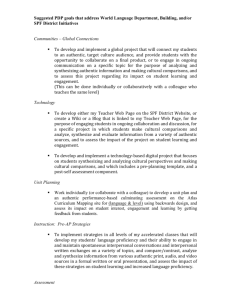Authentic Assessment
advertisement
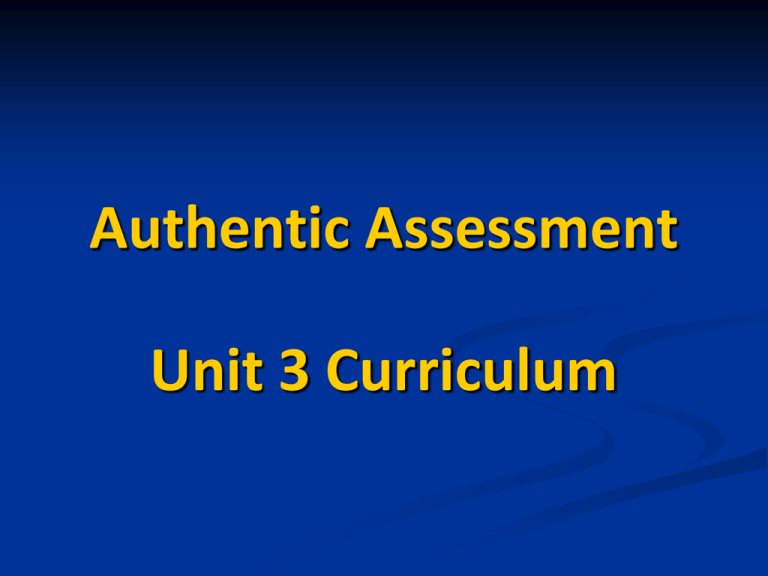
Authentic Assessment Unit 3 Curriculum Authentic Assessment Authentic assessment is any type of assessment that requires students to demonstrate skills and competencies that realistically represent problems and situations likely to be encountered in daily life. Students are required to produce ideas, to integrate knowledge, and to complete tasks that have real-world applications. Authentic Assessment Authentic assessment is a contrast to traditional educational testing and evaluation, which focuses reproducing information such as memorized dates, terms, or formulas. Defining Attributes Of Traditional and Authentic Assessment Traditional Authentic Selecting a Response ------------------ Performing a Task Contrived -------------------------------------------------- Real-life Recall/Recognition --------------Construction/Application Teacher-structured --------------------- Student-structured Indirect Evidence ----------------------------- Direct Evidence Authentic Assessment Students are assessed according to specific criteria that are known to them in advance. These criteria are called rubrics . Sample Open Response Rubric SCORE POINT 4 Distinguished • • • • • SCORE POINT 3 Proficient • • • You follow all directions and finish all parts of the question. You are able to answer the question clearly so that others can understand. You show that you completely understand the information that is asked about. You show and/or explain the quickest and best way to get an answer. You are able to show and explain what you know by using complex examples, by showing connections between ideas and the real world, by comparing different ideas, and/or by showing how the ideas work together. You follow the directions and finish most of the parts of the question. You are able to answer the question clearly so that others can understand. You show and/or explain that you understand the big ideas about the question, but there may be a few little mistakes or wrong ideas. Sample Open Response Rubric SCORE POINT 2 •You follow some of the directions and finish some parts of the question. •Your answer may not be complete, but it is clear so that others can understand. •You understand only parts of the information to answer the question. SCORE POINT 1 •You understand only a small part of the information asked for in the question. •You only answer a small part of the question. SCORE POINT 0 •Your answer is completely wrong or has nothing to do with the question. BLANK •You did not give any answer at all. Sample Rubric 4 Demonstrates complete understanding of the problem. All requirements of task are included in response. 3 Demonstrates considerable understanding of the problem. All requirements of task are included. 2 Demonstrates partial to little understanding of the problem. Many requirements of task are missing. 1 Demonstrates no understanding of the problem. 0 No response/task not attempted. Constructed Response (product-like): Short-answer essay questions "Show your work" Concept maps Figural representation (e.g., Venn diagram) Journal response stories or poems Research reports Art exhibit or portfolio Lab reports Newspaper Poster Constructed Response (performance-like): Typing test Complete a step of science lab On demand, construct a short musical, dance or dramatic response On demand, exhibit an athletic skill Examples of Authentic Assessment http://jonathan.mueller.faculty.noctrl.edu/toolbox /examples/authentictaskexamples.htm Auditory Visual Tactile-Kinesthetic Audio recording Advertisement Acting things out Autobiography Art gallery Activity plan for trip Book Brochure Animated movie Classifying Coat of arms Collection Commentary Collage Composing music Crossword puzzle Coloring book Dance Debate or panel talk Comic book or strip Demonstration Dialogue Costume Diorama Documentary Decoration Dramatization Editorial Design Exhibit Essay Diagram Experiment Experiment Diorama Field experience Fact file Drawing or painting Flip book Family tree Filmstrip Flip chart Auditory Visual Tactile-Kinesthetic Finding patterns Flannel board Game Glossary Flow chart Game show Interview Graphic organizer How-to book Journal or diary Greeting card Invention Learning Center task Hidden pictures Jigsaw puzzle Letter to editor HyperStudio or other Learning center-hands-on Limerick or riddle multimedia presentation tasks Mystery software Manipulatives Newspaper Illustrated manual Mobile Oral report Illustrations Model Learning Center visuals Museum exhibit Petition Magazine Papier-mâché Position paper Map Photograph Press conference Mural Play or skit Pattern and instructions Auditory Visual Tactile-Kinesthetic Reading Pamphlet with pictures or icons Pop-up book Scavenger hunt Photo album Project cube Simulation game Photo essay Puppet show Song lyrics Picture dictionary Rap or rhyme Speech Political cartoon Reader’s Theater Story or poem Portfolio Rhythmic pattern Survey Poster Role-play Teaching a lesson Rebus story Scale drawing Trip itinerary Scrapbook Sculpture Written report Slide show Simulation game Transparency talk Survey Travelogue TV Broadcast TV program Video Web site
